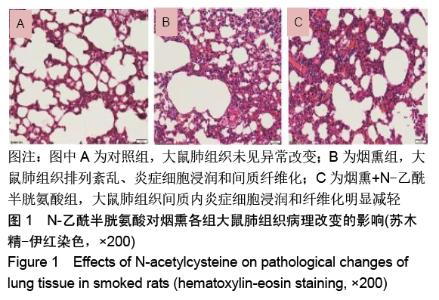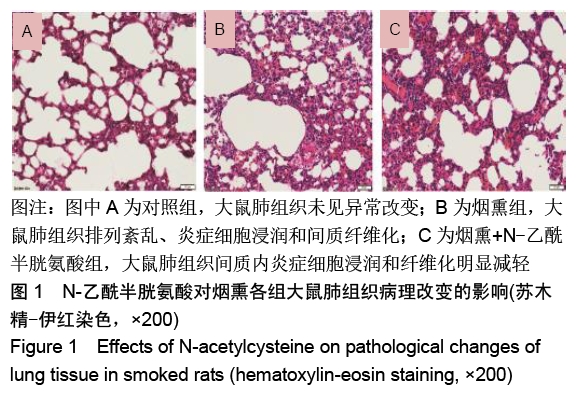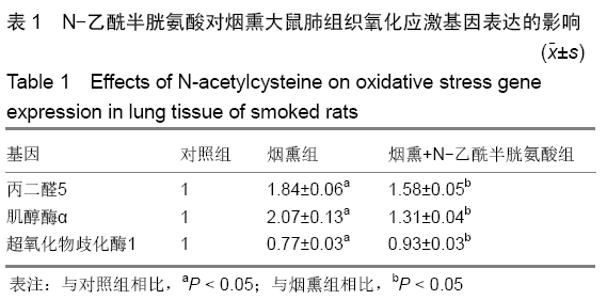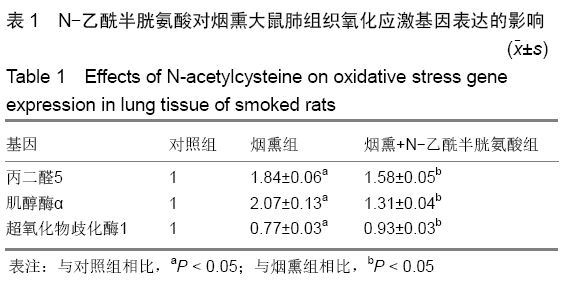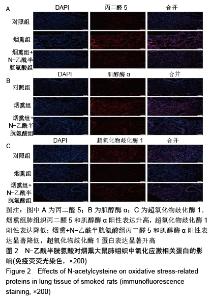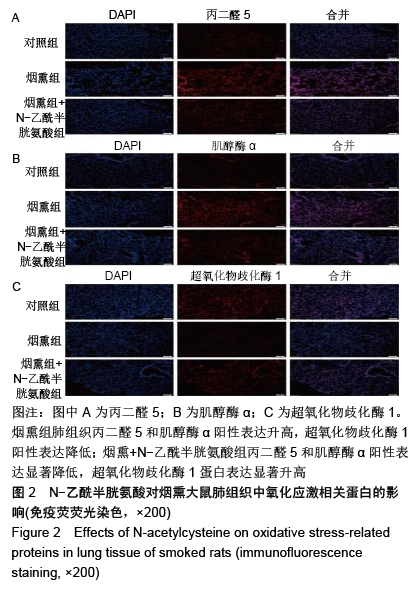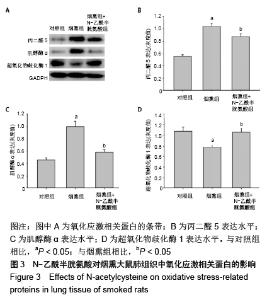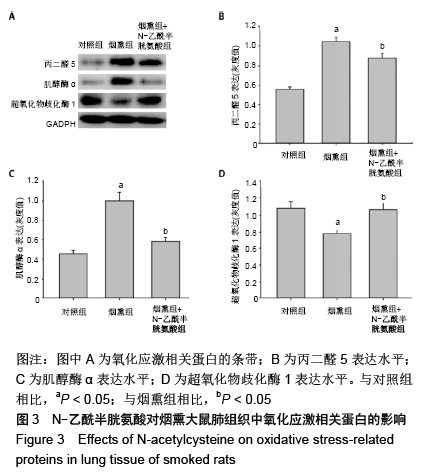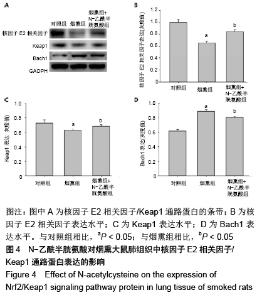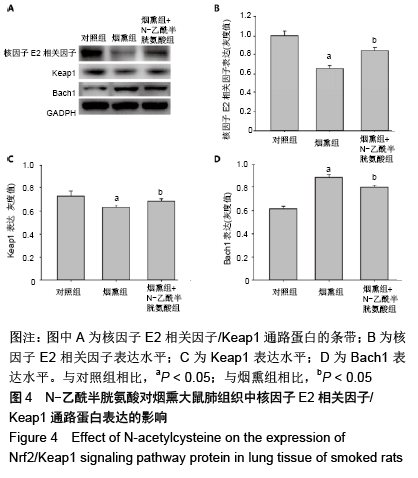Chinese Journal of Tissue Engineering Research ›› 2020, Vol. 24 ›› Issue (2): 254-259.doi: 10.3969/j.issn.2095-4344.1877
Previous Articles Next Articles
Effects of N-acetylcysteine on oxidative stress in lung tissue of smoked rats
Li Xiang1, Wang Wei2, Xia Shuyue1, He Wei1
- 1Intensive Care Unit of Respiratory, Affiliated Central Hospital of Shenyang Medical College, Shenyang 110024, Liaoning Province, China; 2Intensive Care Unit of Respiratory, the First Hospital of China Medical University, Shenyang 110001, Liaoning Province, China
-
Received:2019-05-17Revised:2019-06-11Accepted:2019-07-20Online:2020-01-18Published:2019-12-25 -
Contact:Li Xiang, Intensive Care Unit of Respiratory, Affiliated Central Hospital of Shenyang Medical College, Shenyang 110024, Liaoning Province, China -
About author:通讯作者:李响,沈阳医学院附属中心医院呼吸与危重症学科,辽宁省沈阳市 110024 -
Supported by:the Science and Technology Foundation of Shenyang Medical College, No. 20182032; the Research Project of Health and Family Planning Commission of Shenyang in 2017; the National Key Research and Development Program on Prevention and Control of Major Chronic Non-Communicable Diseases, No. 2016YFC1304502
CLC Number:
Cite this article
Li Xiang, Wang Wei, Xia Shuyue, He Wei. Effects of N-acetylcysteine on oxidative stress in lung tissue of smoked rats[J]. Chinese Journal of Tissue Engineering Research, 2020, 24(2): 254-259.
share this article
Add to citation manager EndNote|Reference Manager|ProCite|BibTeX|RefWorks
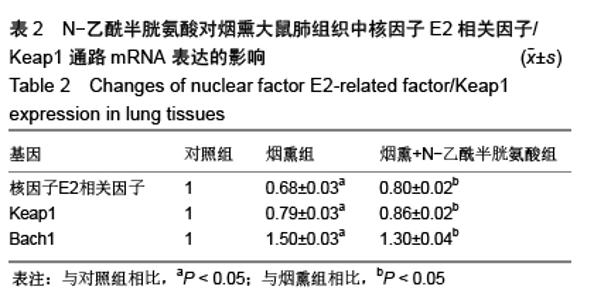
2.5 N-乙酰半胱氨酸对烟熏大鼠肺组织中核因子E2相关因子/Keap1通路mRNA及蛋白表达的影响 核因子E2相关因子/Keap1信号通路对于调节细胞氧化应激的防御机制具有非常重要的作用。 2.5.1 mRNA表达 为了阐明N-乙酰半胱氨酸对烟熏导致肺损伤的作用机制,研究通过实时PCR检测了核因子E2相关因子/Keap1信号通路核因子E2相关因子、Keap1和Bach1 mRNA表达变化。结果发现,与对照组相比,烟熏组大鼠肺组织核因子E2相关因子和Keap1 mRNA表达显著降低,Bach1 mRNA表达增加(P < 0.05),而烟熏+N-乙酰半胱氨酸组核因子E2相关因子和Keap1 mRNA表达明显升高,Bach1 mRNA表达显著降低(P < 0.05),见表2。 "
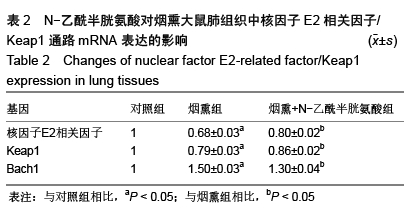
| [1] CHO J, LEE CH, HWANG SS, et al. Risk of acute exacerbations in chronic obstructive pulmonary disease associated with biomass smoke compared with tobacco smoke. BMC Pulm Med. 2019; 19(1):68. [2] MORSCH ALBC, WISNIEWSKI E, LUCIANO TF, et al. Cigarette smoke exposure induces ROS-mediated autophagy by regulating sestrin, AMPK, and mTOR level in mice. Redox Rep. 2019;24(1): 27-33. [3] YELLEPEDDI VK, MOHAMMADPOUR R, KAMBHAMPATI SP, et al. Pediatric oral formulation of dendrimer-N-acetyl-l-cysteine conjugates for the treatment of neuroinflammation. Int J Pharm. 2018;545(1-2):113-116. [4] RABABA’H AM, HIJJAWI TB, ALZOUBI KH, et al. The Nephroprotective Effect of N-Acetyl-L-Cysteine and Atorvastatin against Imipenem induced Nephrotoxicity. Curr Mol Pharmacol. 2018;11(2):155-161. [5] QIAO J, CHEN L, HUANG X, et al. Effects of nebulized N-acetylcystein on the expression of HMGB1 and RAGE in rats with hyperoxia--induced lung injury. J Cell Physiol. 2019;234(7): 10547-10553. [6] HUANG H, CHEN M, LIU F, et al. N-acetylcysteine tiherapeutically protects against pulmonary fibrosis in a mouse model of silicosis. Biosci Rep. 2019;39(7):BSR20190681. [7] ZHANG M, XIA H, YU M, et al. N-acetylcysteine prevents cytotoxic effects induced by man-made mineral fibers in a human bronchial epithelial cell line. Toxicol In Vitro. 2018;53:200-207. [8] ARGAEV FRENKEL L, ROZENFELD H, ROZENBERG K, et al. N-Acetyl-l-Cysteine Supplement in Early Life or Adulthood Reduces Progression of Diabetes in Nonobese Diabetic Mice. Curr Dev Nutr. 2018;3(4):nzy097. [9] GOTTS JE, ABBOTT J, FANG X, et al. Cigarette Smoke Exposure Worsens Endotoxin-Induced Lung Injury and Pulmonary Edema in Mice. Nicotine Tob Res. 2017;19(9): 1033-1039. [10] HERNÁNDEZ-SAAVEDRA D, SANDERS L, PEREZ MJ, et al. RTP801 Amplifies Nicotinamide Adenine Dinucleotide Phosphate Oxidase-4-Dependent Oxidative Stress Induced by Cigarette Smoke. Am J Respir Cell Mol Biol. 2017;56(1):62-73. [11] ŻUKOWSKI P, MACIEJCZYK M, MATCZUK J, et al. Effect of N-Acetylcysteine on Antioxidant Defense, Oxidative Modification, and Salivary Gland Function in a Rat Model of Insulin Resistance. Oxid Med Cell Longev. 2018;2018:6581970. [12] PEI Y, LIU H, YANG Y, et al. Biological Activities and Potential Oral Applications of N-Acetylcysteine: Progress and Prospects. Oxid Med Cell Longev. 2018;2018:2835787. [13] ZHANG H, SU W, YING Z, et al. N-acetylcysteine attenuates intrauterine growth retardation-induced hepatic damage in suckling piglets by improving glutathione synthesis and cellular homeostasis. Eur J Nutr. 2018;57(1):327-338. [14] RENDELL R, FAIRHALL S, GRAHAM S, et al. Assessment of N-acetylcysteine as a therapy for phosgene-induced acute lung injury. Toxicol Lett. 2018;290:145-152. [15] IZUMI S, IIKURA M, HIRANO S. Prednisone, azathioprine, and N-acetylcysteine for pulmonary fibrosis. N Engl J Med. 2012; 367(9):870; author reply 870-871. [16] SJÖDIN K, NILSSON E, HALLBERG A, et al. Metabolism of N-acetyl-L-cysteine. Some structural requirements for the deacetylation and consequences for the oral bioavailability. Biochem Pharmacol.1989;38(22):3981-3985. [17] TSIKAS D, SCHWEDHELM KS, SURDACKI A, et al. S-Nitroso-N-acetyl-L-cysteine ethyl ester (SNACET) and N-acetyl-L-cysteine ethyl ester (NACET)-Cysteine-based drug candidates with unique pharmacological profiles for oral use as NO, H2S and GSH suppliers and as antioxidants: Results and overview. J Pharm Anal. 2018;8(1):1-9. [18] WEI X, LI Y, LI M, et al. The protective effects of Sauropus spatulifolius on acute lung injury induced by lipopolysaccharide. J Sci Food Agric. 2018;98(12):4420-4426. [19] YAN XT, HE XH, WANG YL, et al. Transduced PEP-1-Heme Oxygenase-1 Fusion Protein Attenuates Lung Injury in Septic Shock Rats. Oxid Med Cell Longev. 2018;2018:6403861. [20] MAFFEI FACINÓ R, CARINI M, ALDINI G, et al. Procyanidines from Vitis vinifera seeds protect rabbit heart from ischemia/reperfusion injury: antioxidant intervention and/or iron and copper sequestering ability. Planta Med. 1996;62(6):495-502. [21] YANG Y, SUN Y, YI W, et al. A review of melatonin as a suitable antioxidant against myocardial ischemia-reperfusion injury and clinical heart diseases. J Pineal Res. 2014;57(4):357-366. [22] SMALL DM, SANCHEZ WY, ROY SF, et al. N-acetyl-cysteine increases cellular dysfunction in progressive chronic kidney damage after acute kidney injury by dampening endogenous antioxidant responses. Am J Physiol Renal Physiol. 2018;314(5): F956-F968. [23] YU K, ZHANG J, CAO Z, et al. Lycopene attenuates AFB1-induced renal injury with the activation of the Nrf2 antioxidant signaling pathway in mice. Food Funct. 2018;9(12): 6427-6434. [24] MAELLARO E, CASINI AF, DEL BELLO B, et al. Lipid peroxidation and antioxidant systems in the liver injury produced by glutathione depleting agents. Biochem Pharmacol. 1990; 39(10):1513-1521. [25] POLAVARAPU R, SPITZ DR, SIM JE, et al. Increased lipid peroxidation and impaired antioxidant enzyme function is associated with pathological liver injury in experimental alcoholic liver disease in rats fed diets high in corn oil and fish oil. Hepatology. 1998;27(5):1317-1323. [26] NAIK SR, PANDA VS. Antioxidant and hepatoprotective effects of Ginkgo biloba phytosomes in carbon tetrachloride-induced liver injury in rodents. Liver Int. 2007;27(3):393-399. [27] ANDRADES M, RITTER C, DE OLIVEIRA MR, et al. Antioxidant treatment reverses organ failure in rat model of sepsis: role of antioxidant enzymes imbalance, neutrophil infiltration, and oxidative stress. J Surg Res. 2011;167(2):e307-313. [28] KULECI S, HANTA I, KOCABAS A, et al. The effect of different treatment modalities on oxidative stress in COPD. Adv Ther. 2008; 25(7):710-717. [29] ZHANG Q, JU Y, MA Y, et al. N-acetylcysteine improves oxidative stress and inflammatory response in patients with community acquired pneumonia: A randomized controlled trial. Medicine (Baltimore). 2018;97(45):e13087. [30] ZHENG JP, WEN FQ, BAI CX, et al. Twice daily N-acetylcysteine 600 mg for exacerbations of chronic obstructive pulmonary disease (PANTHEON): a randomised, double-blind placebo-controlled trial. Lancet Respir Med. 2014;2(3):187-194. [31] LAI KY, NG WY, OSBURGA CHAN PK, et al. High-dose N-acetylcysteine therapy for novel H1N1 influenza pneumonia. Ann Intern Med. 2010;152(10):687-688. [32] QIAO J, CHEN L, HUANG X, et al. Effects of nebulized N--acetylcystein on the expression of HMGB1 and RAGE in rats with hyperoxia--induced lung injury. J Cell Physiol. 2019;234(7): 10547-10553. [33] YANG L, DUAN Z, LIU X, et al. N-acetyl-l-cysteine ameliorates the PM2.5-induced oxidative stress by regulating SIRT-1 in rats. Environ Toxicol Pharmacol. 2018;57:70-75. [34] LEE SE, YANG H, SON GW, et al. Eriodictyol Protects Endothelial Cells against Oxidative Stress-Induced Cell Death through Modulating ERK/Nrf2/ARE-Dependent Heme Oxygenase-1 Expression. Int J Mol Sci. 2015;16(7):14526-14539. [35] MCMAHON M, ITOH K, YAMAMOTO M, et al. Keap1-dependent proteasomal degradation of transcription factor Nrf2 contributes to the negative regulation of antioxidant response element-driven gene expression. J Biol Chem. 20033;278(24):21592-21600. [36] OHTA T, IIJIMA K, MIYAMOTO M, et al. Loss of Keap1 function activates Nrf2 and provides advantages for lung cancer cell growth. Cancer Res. 2008;68(5):1303-1309. [37] ZHANG Z, CHENG X, GE D, et al. Protective Effects of Astragaloside IV Combined with Budesonide in Bronchitis in Rats by Regulation of Nrf2/Keap1 Pathway. Med Sci Monit. 2018;24: 8481-8488. |
| [1] | Li Anan, Jiang Tao, Zhan Min, Cai Yuning, Song Min, Li Congcong, Lin Wenzheng, Zhang Jiayuan, Liu Wengang. Pharmacological mechanism of Shenling Baizhu San in the treatment of knee osteoarthritis based on network pharmacology and molecular docking [J]. Chinese Journal of Tissue Engineering Research, 2022, 26(2): 197-204. |
| [2] | Li Wanhai, Dong Yuhang, Shi Chao, Jiang Yiyao, Liu Ge, Diao Wenjie, Wu Zhen. Ligustrazine furoxan complex protects against renal ischemia-reperfusion injury in mice [J]. Chinese Journal of Tissue Engineering Research, 2022, 26(2): 205-210. |
| [3] | Zhu Chunhui, Zhang Yi, Song Huanghe, Liang Wenwei. Protective effect of astaxanthin on tert-butyl hydrogen peroxide-induced chondrocyte damage [J]. Chinese Journal of Tissue Engineering Research, 2022, 26(11): 1648-1655. |
| [4] | Xing Hongchang, Cao Jianping, Zhu Jing, Yao Kun. Mechanism by which enalapril alleviates myocardial injury in a rat model of limb ischemia-reperfusion [J]. Chinese Journal of Tissue Engineering Research, 2022, 26(11): 1747-1751. |
| [5] | Song Huifang, Tan Jiayin, Kang Yi, Li Bin, Bi Zhifei, Long Nü, Xia Zhongnian, Guo Rui. Hypoxic pretreatment enhances the protective effect of aged human bone marrow mesenchymal stem cells conditioned medium against H9C2 oxidative stress damage [J]. Chinese Journal of Tissue Engineering Research, 2022, 26(1): 1-6. |
| [6] | Pei Lili, Sun Guicai, Wang Di. Salvianolic acid B inhibits oxidative damage of bone marrow mesenchymal stem cells and promotes differentiation into cardiomyocytes [J]. Chinese Journal of Tissue Engineering Research, 2021, 25(7): 1032-1036. |
| [7] | Li Jia, Fu Tingting, Ma Yuanchen, Liu Xiangqian, Chen Min. Serum inflammatory mediators and oxidative stress in patients with type C distal radius fractures treated with external fixator combined with mid-frequency pulse therapy [J]. Chinese Journal of Tissue Engineering Research, 2021, 25(33): 5351-5355. |
| [8] | Guo Minfang, Zhang Huiyu, Zhang Peijun, Bai Zhenjun, Yu Jingwen, Wang Yuyin, Wei Wenyue, Song Lijuan, Chai Zhi, Yu Jiezhong, Ma Cungen. Fasudil inhibits lipopolysaccharide-induced astrocytic injury by regulating Nrf2/HO-1 signaling pathway [J]. Chinese Journal of Tissue Engineering Research, 2021, 25(31): 5012-5017. |
| [9] | Xue Qing, Tong Liangcheng, Yang Zhiwei, Wang Jianling, Zhao Lei, Zhou Sheng, Peng Sai, Li Ying. Epigallocatechin gallate alleviates skeletal muscle ischemia-reperfusion injury in rats [J]. Chinese Journal of Tissue Engineering Research, 2021, 25(26): 4145-4149. |
| [10] | Luo Anyu, Liu Hanlin, Xie Xiaofei, Huang Chen. Effect of antioxidant mixture on structural degeneration of an osteoarthritis rat model [J]. Chinese Journal of Tissue Engineering Research, 2021, 25(23): 3625-3629. |
| [11] | Liao Yuan, Qu Mengjian, Liu Jing, Zhong Peirui, Zeng Yahua, Wang Ting, Xiao Hao, Li Lan, Liu Danni, Yang Lu, Zhou Jun. Effects of ultrashort wave on inflammatory response in rats with acute lung injury [J]. Chinese Journal of Tissue Engineering Research, 2021, 25(2): 253-257. |
| [12] | Liu Kun, Xie Lin, Cao Jun, Ding Ning, Xu Lingbo, Ma Shengchao, Li Guizhong , Jiang Yideng, Lu Guanjun. Increased FoxO1 DNA methylation level in homocysteine-induced podocyte apoptosis [J]. Chinese Journal of Tissue Engineering Research, 2021, 25(2): 269-273. |
| [13] | Cong Renyuan, Yuan Jing, Xia Jinchan, Sun Ying . Effects of baicalin on oxidative stress in BEAS-2B cells stimulated by lipopolysaccharide combined with adenosine triphosphate [J]. Chinese Journal of Tissue Engineering Research, 2021, 25(2): 286-291. |
| [14] | Zhou Yi, Chen Yueping, Zhang Xiaoyun, Lai Yu, Liao Jianzhao, Li Shibin. An exploration on mechanism of Shengyu Decoction in treating osteonecrosis of the femoral head based on network pharmacology [J]. Chinese Journal of Tissue Engineering Research, 2021, 25(17): 2687-2696. |
| [15] | Yuan Baohong, Zhao Weishan, Wang Ruotian, Guan Aoran, Wang Yu, Li Ruhong. Bone marrow mesenchymal stem cells from pigs inhibit inflammatory response induced by lipopolysaccharide and improve islet cell dysfunction in pigs [J]. Chinese Journal of Tissue Engineering Research, 2021, 25(13): 1969-1975. |
| Viewed | ||||||
|
Full text |
|
|||||
|
Abstract |
|
|||||
